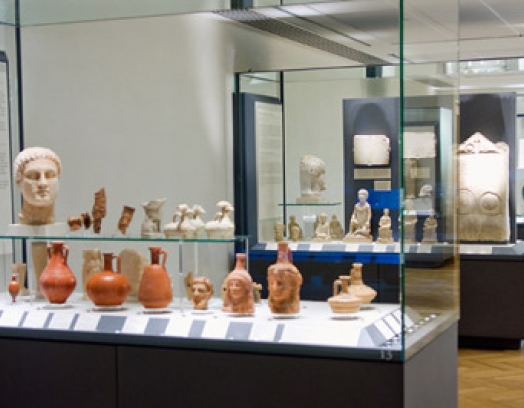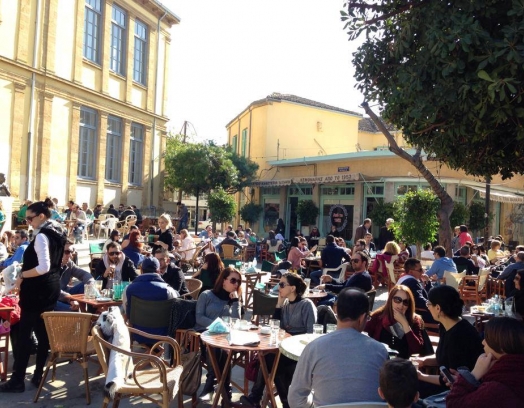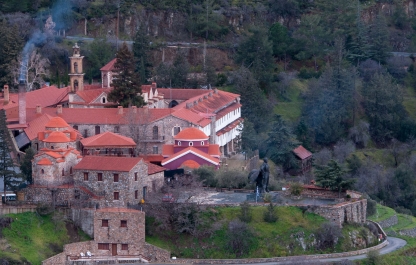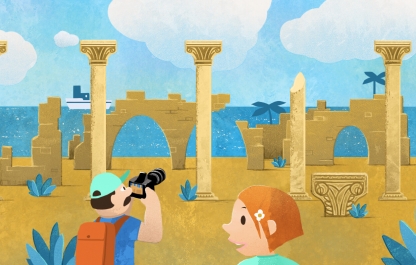Kalopanayotis, a village in a mountain region of the island is where you’ll find Agios Ioannis Lambadistis Monastery on the bank of the river Setrachos. It was here that Heraclides (the first bishop of Tamassos) was baptized.
It is believed that the monastery was founded in the 12th century. However, it is first referenced in a written document in the 18th century. Russian monk and pilgrim Vasily Grigorovich-Barsky wrote that he paid his respects to the immortal remains of Agios Ioannis Lampadistis (St. John Lampadist) here. There are also references to the monastery in the work, History of Cyprus, published in 1788. It is recorded that the monastery fell under the jurisdiction of Kyrenia and was considered prosperous.
In the mid-19th century, Agios Ioannis Lambadistis Monastery fell into disrepair and decline as did many other monasteries in Cyprus: one of the monastic cells was used as classroom for the rural school and the rest were abandoned entirely. The monastery was added to the UNESCO World Heritage List in 1985 and even then it housed a museum for a short while thereafter. It was only recently that the monastic community returned and took up residence in the restored cells.
St. John, after whom one of the two churches of the monastery’s ensemble was named, was born into a priest's family and was preoccupied with questions of faith from a young age. The time came for him to marry and a bride was chosen for him from a neighbouring village. However, he declared that he wanted to devote his life to serving God. This greatly angered his family and the bride's parents wanted to take revenge on John and set a village sorcerer on him. He survived but was blinded.
Subsequently, John left his father's house and moved to the Monastery of St. Herakleidios (after whom the second church in the monastery’s ensemble is named). At the age of 22, St. John died, and he might well have been forgotten if it hadn’t been for what happened years later: a pilgrim visited the grave of St. John and was miraculously cured of his illness. This inspired a wave of pilgrims to visit the grave. The church was built over the grave where St. John lies and houses his miraculous remains to this day.
The older of the two churches in the monastery ensemble is thought to have been built in the 11th century. It is consecrated in honour of St. Herakleidios, who was converted to Christianity by the apostles Paul and Barnabas in the year 45.
The dome of the ancient church is supported by four columns that are built into the stone walls. The interior walls were decorated with frescoes and some fragments have survived to this day. You can see part of a Byzantine ornament and the image of the kneeling monks depicted in the altar.
The church’s interior was renovated in the 13th century and a wide range of new frescoes were added to the walls. It was renovated again in the 14th century and the frescoes lost some of their former grandeur.
Nowadays, the church still boasts frescoes from the 13th century: the Resurrection of Lazarus, the Crucifixion, Jesus’ Triumphal Entry into Jerusalem and others.
The dome of the church is adorned with an image of Christ Almighty in a purple chiton (tunic) surrounded by the entire Heavenly host. The church’s southern vault has a fresco depicting the Ascension of Christ.
There are 30 frescoes from the 15th century depicting scenes from the New Testament: the Annunciation, the Passion of the Lord and others. There are also figures of saints and martyrs, including Marina, Paraskeva and Kyriaki — female saints that are revered on the island.
The church’s ancient iconostasis with Byzantine ornamentation depicting a two-headed eagle, a Lusignan lion, Frankish bear and other symbols of the Latin knights dates back to the 13th century. To the left and right of the Holy Doors, there are the icons of Archangel Michael and St. Iraklidis.
The church is connected to church of St. John Lampadist, built in the 12th century by way of an archway cut into its north wall. What’s more, there is a covered chamber, a sort of narthex, in the western part of the church.
The walls and arches in the Church of St. John Lampadist are decorated with murals. The inscriptions on the south wall of the western side-chapel contain information about an artist from Constantinople who worked on creating the church’s frescoes.
It is worth mentioning the design of the walls of the narthex: they depict the Last Judgment and scenes from the Old Testament. The western wall of the antechamber has 23 miniatures dedicated to church holidays: the frescoes are arranged in the order that these holidays take place according to the church calendar.
The monastery ensemble also boasts a third church: a Latin chapel from the 15th century. The icons decorating the chapel are in keeping with the Italo-Byzantine style with its characteristic elegance and golden ratio. The chapel’s frescoes are so exquisite that some researchers believe that their artist must have been well versed in the techniques of Italian painting and was influenced by the Florentine artist Giotto.
The chapel’s north and south walls are decorated with images of the Akathist glorifying the Virgin. They have been painted in the Byzantine style (each icon corresponds to a verse of the hymn and is illustrated with the letter of the Greek alphabet with which it begins). The last letter, omega, corresponds to the image of the Virgin with Christ in her arms.
The chapel’s eastern wall is adorned with the mural, The Appearance of Three Angels to Abraham, which is the Byzantine equivalent of the Holy Trinity.
Another fresco depicts the story of how the prophet Moses saw the face of the Virgin and Child glowing in the burning bush — one of the key Old Testament traditions. The chapel also has a fresco depicting Moses receiving the Ten Commandments on stone tablets.








